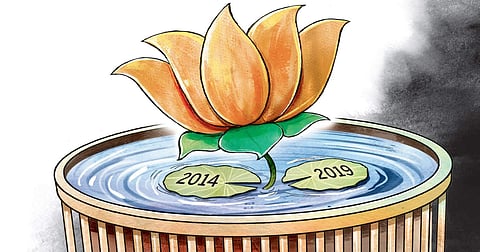

If 2014 was about the collective aspiration represented by one leader, 2019 is about his pro-nation and pro-people intentions, all the failures and limitations in public policies notwithstanding. 2019 verdict signified a wave that was silent until it came out in the exit-polls. However, the relative absence of the same trends on the ground generated a polarized debate over the exit polls’ inadequacy as they didn’t align with the reports that were coming out after every phase of the election.
It was believed that opposition alliances in crucial states like Uttar Pradesh, Bihar, Maharashtra and Karnataka would do reasonably well as their core social support bases were strong. Guided by that assumption, it was believed that the BJP would lose a significant number of seats in the north, central and west Indian states wherein it already plateaued in 2014.
It was also assumed that the BJP’s bid to reach eastern states to compensate for the losses would be a non-starter as it doesn’t have the organisational strength in states like West Bengal and Odisha. It was also staring at a backlash in Assam on account of its attempt to pass the Citizenship Amendment Bill, 2016. However, all the above assumptions have proven to be completely wrong now. The BJP has crossed 300 seats on its own while the NDA’s tally hit around 350!
This victory acquires significance not only because of the number of seats that the BJP and NDA got but rather its ability to recover from the recent defeats in Rajasthan, Madhya Pradesh and Chhattisgarh just months ago.
However, before attempting to decipher the BJP’s victory, one needs to analyse the state of opposition parties, particularly the Congress. In fact, this verdict is as much about the crisis of opposition parties in India as about the Modi wave.
First, the Congress lost traction completely in a short span of time in the three states where it won Assembly polls by not fulfilling the promises made to the people, especially the farmers. During my field visit to Rajasthan, the farmers’ anger with the Congress government was visible as the party had backtracked on its poll-clinching promise of waiving farmers’ loan. It was pointed out that the government had waived off loans—up to 50,000—taken by smaller farmers from cooperative banks. At the same time, it left a majority of farmers who had borrowed from large banks in the lurch.
Secondly, the Congress spent more time in attacking Prime Minister Narendra Modi rather than offering an alternative narrative. We found that majority of the respondents were unaware of the Congress’ NYAY scheme, thus turning the promise a non-starter. The party seemed to have invested a majority of its time in media narratives, instead of working on the ground.
Thirdly, despite all the hype about opposition unity, it materialised only in Bihar and partly in Uttar Pradesh. Everywhere else the participants contested separately. While this created an expectation for the emergence of a formidable anti-BJP narrative, the same couldn’t fracture the strong social base that the BJP had meticulously crafted out of upper castes, lower OBCs and a significant section of numerically weaker Dalits since 2014.
On the other hand, the BJP emerged quickly from the crisis of allies it was facing by stitching an alliance with the Shiv Sena in Maharashtra, and the JD(U) and LJP in Bihar by agreeing to contest less seats as compared to 2014. In Assam, the party forged an alliance with the AGP whose pro-Khilonjia (indigenous) credentials helped the party overcome the backlash it faced over the Citizenship Amendment Bill.
However, most importantly, the significant feature was the BJP outsmarting the opposition in the exercise of perception constitution. Surprisingly, the entire electoral narrative was centred upon the narratives of nationalism and a decisive leader—something that Modi wanted the opposition to react to. Nowhere, the issues of agrarian crisis, rural distress, joblessness, the crisis of informal sector after demonetisation—tangible material issues that had put BJP on the backfoot months ago– were allowed to become the central narrative.
Rather, the cracks in the opposition ranks were visible in crucial states of UP and Bihar wherein while the Congress contested separately in the former, in Bihar RJD leader Tejaswi Yadav refused to accommodate candidates of the Congress and CPI, like Shakeel Ahmed and Kanhaiya Kumar. In fact, inexperienced or wrongly advised, the RJD called the CPI a party of feudal forces and Kanhaiya the representative of upper caste militia Ranveer Sena.
Quite significantly, the BJP even succeeded in breaching the Bengal fort by winning nearly 18 out of 42 seats with a vote share of almost 41 per cent, indicating that it has significantly eaten into the CPM support base while capturing space from the Congress and Trinamool.
This change in the East speaks volumes about the ideological shift India is witnessing today. And the opposition, be it on narrative, public outreach or ideology, seems to be in a state of deep crisis. In this backdrop, 2019 heralds a phase when the entire ecosystem of opposition is staring at a deeper crisis as of now.
(The author is a political analyst associated with Peoples Pulse. Email: sajjanjnu@gmail.com)